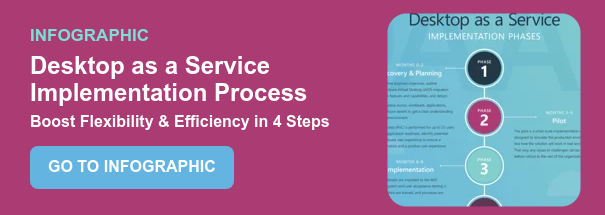Debunking Desktop as a Service (DaaS) Myths and Misconceptions
Desktop as a Service (DaaS) has become a valuable tool in the evolving landscape of cloud computing, offering flexibility and efficiency to businesses. However, misconceptions about DaaS often lead to hesitation in its adoption. We want to debunk some common myths surrounding DaaS, providing clarity to those considering its integration into their business model.
Before we do that, let’s ensure that we are working from a shared understanding of what DaaS is.
What is DaaS?
Desktop as a Service, commonly called DaaS, is an innovative cloud computing service where a cloud service provider hosts the backend of a virtual desktop infrastructure (VDI). DaaS leverages virtualization technology to create virtual desktops. These virtual desktops are hosted on servers in a datacenter managed by the DaaS provider. Users can access these virtual desktops over the Internet or a private network using any compatible device: Windows, Mac, Linux, or even a modern web browser.
All the computing resources, including storage, memory, and processing power, are centralized in the cloud. This centralization allows for better management, security, and scalability.
Watch this video that explains how DaaS works and the benefits of DaaS:
Now that we have defined DaaS let’s debunk some common misconceptions.
Myth 1: With DaaS, I have to move everything to the cloud.
Often, DaaS is utilized as a hybrid approach. You can move desktop environments to the cloud while maintaining on-premises solutions for specific needs. You can even move specific groups of users, like contractors or seasonal employees, to a DaaS environment.
This flexibility means you can enjoy cloud benefits without altogether abandoning existing infrastructure. Some organizations will benefit more from an all-or-nothing approach; others would be misguided going this route. A thorough assessment of your workloads can determine what’s the best path.
Myth 2: DaaS is more expensive than RDS.
While the upfront cost of DaaS might seem higher than traditional Remote Desktop Services (RDS), it often results in long-term savings. DaaS eliminates the need for extensive hardware investments and reduces maintenance and upgrade costs. Make sure to calculate your return on investment over a multi-year timeframe. Additionally, DaaS can allow many organizations to purchase less expensive endpoints and extend the lifespan of their existing device fleet.
Myth 3: DaaS takes too long to implement.
Implementation time varies based on complexity and scale, but DaaS typically offers a quicker setup than traditional desktop solutions. DaaS providers have streamlined processes, making deployment faster and more efficient. The key is to get organizational alignment on your commitment to moving to VDI.
Myth 4: DaaS isn’t compatible with our infrastructure/apps.
Modern DaaS solutions are designed with compatibility in mind. They can integrate with various infrastructures and applications, including legacy systems, ensuring a seamless transition and operation. Fully cloud-based organizations have less need for DaaS than those with technical debt.
Myth 5: DaaS causes performance (speed) issues.
DaaS often matches or exceeds traditional desktops' performance, thanks to high-end servers. Performance issues, if they occur, are usually linked to a design that doesn't align well with your specific requirements or insufficient testing of the system in real-world scenarios before it's fully deployed.
Myth 6: DaaS makes it more difficult to manage users' desktops.
Contrary to this belief, DaaS simplifies desktop management. It centralizes desktop environments, allowing for easier updates, security patches, and policy enforcement. This centralization reduces the workload of IT teams significantly. Changes can be made once and rolled out in a controlled manner, improving consistency and user experience.
Myth 7: DaaS puts the company’s sensitive information at risk.
Security in DaaS environments is robust. Providers implement stringent security measures, including data encryption, secure datacenters, and regular security audits. In many cases, DaaS can enhance your data security compared to traditional setups. Protecting a multi-session host with ten users is far easier than protecting ten individual endpoints.
Myth 8: My users won’t understand how to use a virtual desktop.
User experience in a DaaS environment is intuitive and often identical to a physical desktop. Training requirements are minimal, and most users adapt quickly to the virtual desktop interface. Concerned organizations would be wise to have a pilot team that can provide feedback and champion the adoption of DaaS to the masses.
Myth 9: DaaS Offers Limited Customization Options.
DaaS is highly customizable. Users can tailor their virtual desktops to meet specific business requirements and preferences like traditional desktops. This flexibility allows businesses to configure environments that align with their unique operational needs.
Myth 10: DaaS is Only Suitable for Large Enterprises.
DaaS is scalable and cost-effective for businesses of all sizes. Its pay-as-you-go model and minimal upfront investment make it attractive for small and medium-sized businesses, not just large enterprises.
DaaS is a reliable, efficient, and cost-effective solution for businesses seeking to modernize their IT infrastructure. By debunking these myths, companies can make informed decisions about incorporating Desktop as a Service into their technology strategy. As a top Microsoft partner and Azure partner, we can help determine what cloud approach is right for your organization. Reach out to us.

Director of Marketing Rebecca leads ProArch's marketing efforts, seamlessly blending technology and storytelling to assist clients in their buying journey. She is dedicated to presenting technological solutions in a compelling manner that drives significant growth for the company. Collaborating closely with sales, engineering, leadership, and HR teams, Rebecca sets the strategic vision for ProArch and ensures alignment across the organization. Her strategic, visionary, and detail-oriented approach shapes ProArch’s brand to be synonymous with reimagining technology to achieve business objectives.


